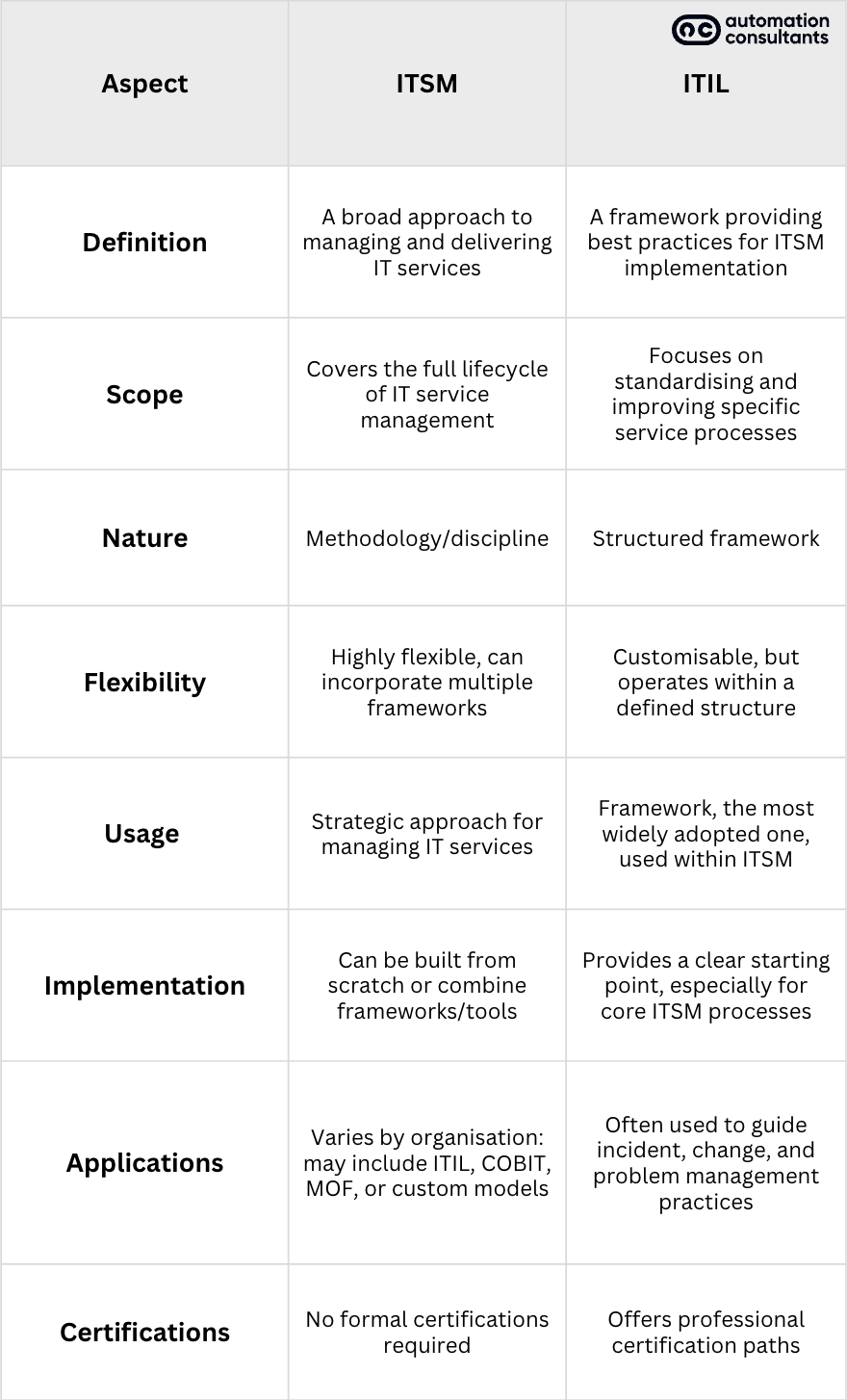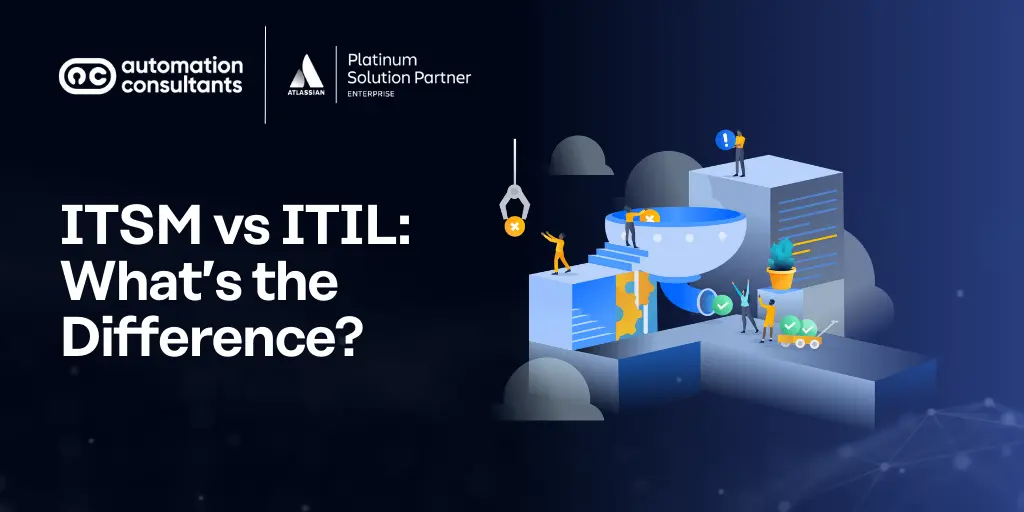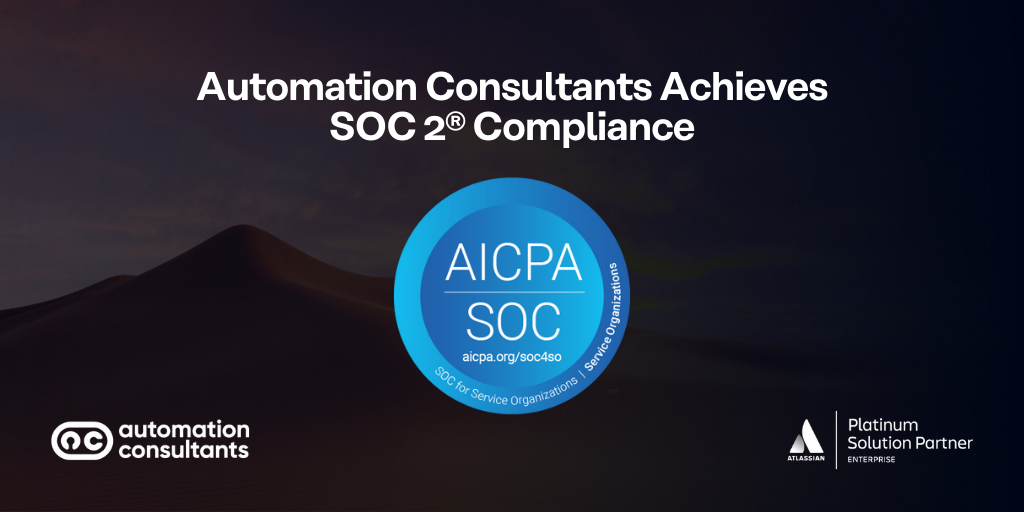It is a truth universally acknowledged, that a business in possession of a good IT department, must be in want of process optimisation. Jokes and mutilated literary quotes aside, IT teams are responsible for delivering IT services and managing technologies. This includes receiving — and quickly responding to — requests from users when they need help with technology.
ITSM and ITIL both provide efficient processes for managing these user requests, and are so closely related that most people assume they are the same thing. Let’s do an ITSM vs ITIL comparison to understand how they are different.
What is IT Service Management?
Information Technology Service Management, or ITSM, is a concept based on the premise that information technology requests, even if internal, should be handled like a professional service. The process should be consistent, measurable, and continually improving.
ITSM promotes a systematic approach to designing streamlined services. It also offers processes for deploying and managing them through a structured ITSM framework designed to align IT services with business needs. Read our ITSM guide here.
Whilst IT support is an important part of ITSM, there’s more to it than just that. Its core principle is efficiency: systems should be optimised to work for your organisation. They should make your IT work more effectively. If a request comes in, whether from an internal team or customers, there should be a process to address it quickly and competently.
Since speed and efficiency are important in ITSM, most tools to implement it come with automation built in. AI and natural language processing (NLP) are used not just to improve responsiveness, but also to empower users to find the answers themselves. Only if they are unable to find the information in your organisation’s knowledge bank is the ticket escalated to the IT team.
As a result, both the team and users can find answers and resolve issues more quickly.
Read all about the ITSM best practices that will help you achieve more efficient processes.
What is the ITIL framework?
ITIL, short for Information Technology Infrastructure Library, is a widely used framework for ITSM that provides a set of best practices for delivering and managing IT services. Developed by the UK Government in the 1980s, it was originally designed to standardise IT service delivery and has since become one of the most popular ways to implement ITSM.
Unlike a tool or software, ITIL is a structured set of guidelines that helps organisations improve service quality, enhance customer satisfaction, and align IT operations with business objectives.
It covers core ITSM processes such as:
- Incident management
- Change management
- Problem management
- Service level management
- Configuration management
- Service strategy
These practices form the foundation for efficient and reliable IT service delivery.
The latest version, ITIL 4, has been updated for modern digital environments. It introduces the Service Value System (SVS) and integrates principles from Agile, Lean, and DevOps, promoting a more flexible, value-driven approach to service management.
While ITSM is the broad discipline, ITIL is one way to implement it — think of ITSM as the ‘what’ and ITIL as one possible ‘how’, with COBIT, MOF, or even custom-built practices being other options. Many popular ITSM tools follow ITIL principles, but ITIL itself isn’t a product.
Adopting ITIL helps organisations streamline processes. It allows IT operations to stay aligned with business goals and continuously improve service performance. It also offers a certification path for IT professionals (commonly referred to as ITIL certification), supporting skill development and operational maturity.
The relationship between ITSM and ITIL
Now that we’ve defined both ITSM and ITIL, it’s easier to see why they’re often confused. They’re closely related, but not interchangeable.
ITSM is the overarching discipline or methodology that outlines what you should do to manage IT as a service.
ITIL, on the other hand, is one of the most widely used frameworks within the ITSM space. It provides detailed guidance on how you should put ITSM principles into practice.
In other words, ITSM sets the strategy, whereas ITIL provides one possible roadmap to achieve it.
Many organisations adopt ITIL processes for ITSM implementation, but others may combine ITIL with other frameworks. This modularity is part of what makes ITSM so flexible.
So, whilst you don’t need ITIL to do ITSM, it’s often the first — and most practical — step to formalise and improve your service management approach.
Differences between ITSM and ITIL
Framework vs. approach
ITSM is a strategic approach to managing IT as a service. It includes everything from incident resolution to long-term planning.
ITIL is a framework — a structured guide that supports the implementation of ITSM practices. It doesn’t replace ITSM, but rather provides a way to do it more efficiently.
Scope and focus
ITSM is the overall discipline that defines how organisations should design, deliver, and manage their IT services. ITIL, on the other hand, is one specific framework within that broader landscape.
Where ITSM covers the entire lifecycle of IT service delivery, ITIL focuses on how to implement those processes effectively, using a standardised, best-practice approach.
Flexibility and customisation
ITSM is inherently flexible. It’s not tied to a single methodology and can incorporate multiple frameworks.
ITIL is also adaptable, with room to tailor its guidance to fit various environments, sizes, and goals. That said, it still operates within a defined structure, which may feel more prescriptive than some teams are used to.
Implementation strategies
ITSM can be implemented in several different ways — through in-house models, ITSM tools, or by adopting industry frameworks. There’s no single path; it’s about building a structure that suits your organisation’s needs and aligns with your business objectives.
ITIL, by contrast, offers a more defined starting point. Many teams start their ITSM journey by adopting ITIL practices — particularly in areas such as incident management and change management — because it provides a clear, proven foundation. It also includes optional certification and maturity models, which can help guide long-term improvement.
Here’s a summary of the differences between ITSM and ITIL:

Looking for a deeper understanding of ITIL? We’ve a detailed ITIL guide that explains its processes and practices. Read it here.
Benefits of ITSM
Enhanced IT service delivery
ITSM introduces well-defined processes that improve how IT services are delivered and supported across the organisation. These standardised workflows help teams resolve issues faster with more reliability and fewer delays.
Improved customer satisfaction
By implementing the guiding principles of ITSM, IT teams should be in a position to consistently meet or exceed expectations. Clearer service expectations and faster response times mean that both internal and external users get a smoother experience. As a result, they are more satisfied with your service, which helps build trust.
Better risk management
Effective service management includes identifying potential issues before they escalate. ITSM enables better visibility and control over risks, which allows teams to take proactive steps to minimise disruption and maintain service continuity.
Alignment with business objectives
ITSM ensures that IT activities are always in sync with the wider business objectives. Because it focuses on strategic alignment, it helps you deliver more than just technical support; it helps you deliver real business value.
Efficiency gains across IT operations
A structured ITSM approach eliminates ad hoc practices and replaces them with streamlined, repeatable processes. This leads to greater consistency, fewer errors, and improved use of time and talent.
Lower operational costs
You can use ITSM to replace duplicated or inconsistent work with standardised, centralised processes. When teams follow the same structured approach, overlap is minimised and tasks aren’t repeated unnecessarily.
Combined with automation and streamlined workflows, this results in lower operational costs and a more efficient use of IT resources.
Smarter resource optimisation
Without proper visibility, you can’t manage workloads or service demands, especially if they vary. ITSM provides the visibility your managers need to deploy resources more effectively, thereby improving productivity.
Want a more detailed list of ITSM benefits? Read our Benefits of ITSM post.
Benefits of ITIL
Structured processes for predictable outcomes
ITIL provides a proven framework for consistently and repeatably managing IT services. This structure helps reduce ambiguity, making it easier for teams to deliver reliable, high-quality services.
Proactive approach to problem management
Investigating root causes and implementing preventative measures is a big part of ITIL. Because it effectively preempts problems before they can disrupt operations, it reduces recurring issues and supports long-term service stability.
Standardised service management practices
From incident management to change control, ITIL defines clear steps for core processes. This consistency ensures everyone is on the same page. It also reduces friction and increases operational maturity.
Optimised use of people and tools
By defining roles, responsibilities, and workflows, ITIL makes it easier to maximise the value of existing resources. Teams are more focused, and tools are better aligned with business needs.
Continual service improvement
ITIL places a strong emphasis on evaluating and improving processes over time. This built-in focus on continual refinement helps organisations stay Agile and relevant in a rapidly changing IT landscape.
Implementation strategies for ITSM and ITIL
Implementing ITSM or integrating ITIL best practices isn’t just about buying new tools or ticking off compliance boxes. It requires a structured, strategic approach that considers your organisation’s specific needs, people, and existing processes.
Here’s a step-by-step guide to getting started:
Assess organisational needs
Before introducing any changes, take time to understand your organisation’s IT Service Management requirements. What challenges are you facing? Are service requests falling through the cracks? Is your team spending too much time on manual tasks? A clear view of current pain points will help define your priorities and guide the rest of the implementation process.
Evaluate existing processes
Next, analyse your current IT operations. Which processes already exist? Are they consistent, or are teams working in silos? Identify gaps, redundancies, or inefficiencies that could be addressed through structured service management. This forms the baseline for improvement.
Engage key stakeholders
Successful implementation relies on buy-in from the people who will use and support the system every day. Involve IT teams, department heads, and executive sponsors early in the process. Their input can highlight overlooked needs, and their support can help drive adoption across the business.
Choose the right tools
There’s no shortage of ITSM tools on the market, many of which support ITIL-aligned processes out of the box. When choosing a solution, look for features like workflow automation, self-service portals, knowledge base integration, and reporting dashboards. But more importantly, choose a tool that fits your existing structure and can scale as your needs evolve.
Which ITSM tool would we recommend? Why, Jira Service Management, of course. Take a look at how it can take your ITSM implementation to the next level.
Integrate ITIL best practices
If you’re adopting ITIL as part of your ITSM strategy, start with the practices that match your most immediate needs. You don’t have to implement every ITIL process at once. Begin where the impact will be most noticeable and expand gradually from there.
Iterate and improve
Implementation isn’t a one-and-done exercise. Build in regular reviews to assess performance, gather feedback, and refine your approach. Whether you’re improving service desk responsiveness or aligning with shifting business objectives, continuous improvement should be a core part of your strategy.
Implementing ITSM with Automation Consultants
Success depends on more than just implementing frameworks. You need the right strategy, tools, and expertise to put them into practice.
If you’re exploring how to move from theory to implementation, our ITSM consulting services can help. We work with organisations to design and optimise service management strategies that align with business goals, whether that involves ITIL, custom frameworks, or a hybrid approach.
Read more about our ITSM consulting services





